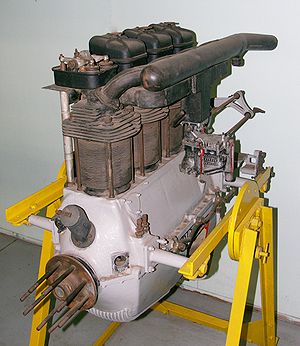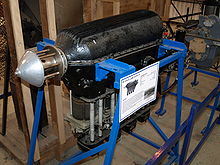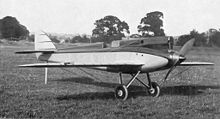- de Havilland Gipsy
-
Gipsy Gipsy II Type Air-cooled 4-cylinder inline piston engine National origin United Kingdom Manufacturer de Havilland First run 1927 Major applications de Havilland D.H.60G Gipsy Moth
de Havilland D.H.71 Tiger Moth racerDeveloped into de Havilland Gipsy Major The de Havilland Gipsy is a British air-cooled 4-cylinder in-line aircraft engine designed by Frank Halford in 1927 to replace the ADC Cirrus in the de Havilland D.H.60 Moth light biplane.
The Gipsy went on to become one of the most famous sport aircraft engines of the inter-war period and was the engine of choice for various other light aircraft, trainers, liaison aircraft and air taxis, British as well as foreign, until long past WWII. Apart from helping to establish the de Havilland Aircraft Company as a manufacturer of light aircraft, it also established the company as an engine manufacturer in its own right.
Contents
Design and development
Just like the ADC Cirrus, the Gipsy was born as a collaboration between aircraft manufacturer Geoffrey de Havilland and engine designer Frank Halford. In fact, the early history of the Cirrus and Gipsy were linked through de Havilland's D.H.60 Moth.
Cirrus origins
In 1925 Geoffrey de Havilland was looking for a reliable cheap engine for use in a light sports aircraft. More particularly, he was looking for something like his favourite World War I aircraft engine: the 240 horsepower (hp) Renault V8, but with half the weight and half the power. Halford gave it to him by building a 4-cylinder crankcase and adding to it half of the Renault's cylinders, several other of the Renault’s components, and standard parts used in car engines. The result was a 60 hp (45 kW) in-line aircraft engine that, although it fell short of the promised horse-power, was still superior to all contemporary engines for light aircraft. Most importantly it was a true aircraft engine at a time where its competitors were more often than not motorcycle engines adapted to running at high altitude. The engine secured, de Havilland Aircraft commenced manufacture of the D.H.60 Moth and the combination of reliable powerplant - the ADC Cirrus - and reliable training craft – the Moth - marked the start of serious sports flying in Britain.
By 1927 however, the Moth threatened to become a victim of its own success as continuing demand was depleting the stockpiles of surplus Renaults needed to build its Cirrus engine. The Moth now having provided a solid financial cushion, de Havilland Aircraft decided to take the problem head-on and start its own engine factory. Geoffrey de Havilland again went to his old friend Halford and this time asked him to design a completely new aircraft engine of weight and performance comparable to the latest version of the Cirrus (the 105 hp (78 kW) Cirrus Hermes).
DH.71 Tiger Moth racer
Main article: de Havilland DH.71 Tiger MothHalford and de Havilland quickly agreed on a 135 hp (101 kW) test engine later to be de-rated to 100 hp (75 kW) for production models. While Halford went to build the engine, de Havilland designed its test-bed: the diminutive D.H.71 racer.[1] Two D.H.71s were built and although in a bout of over-confidence named Tiger Moth, their racing career was rather uneventful. Their only notable claim to fame came in capturing a world speed record of 186 mph (299 km/h) for their weight class. (The name Tiger Moth would later be used again for the D.H.82 trainer and with this aircraft gain more than its share of fame.) What the D.H.71 did not accomplish in racing successes, it did accomplish in developing the new engine and by the time the career of the D.H.71 was over, the 100 hp (75 kW) production version of its engine, now named the Gipsy, was ready to start its career.
Technical description
Like the Cirrus, the new Gipsy was an air-cooled 4-cylinder in-line engine weighing a mere 300 pounds and rated at 98hp (73kW) at 2,100 rpm. The cylinders had a bore of 4.5in and a stroke of 5in (114mm × 128mm) for a displacement of 319cu.in (5.23l). It was soon developed further into the 120hp (90kW) Gipsy II; both types were to be used in the new version of the de Havilland Moth: the D.H.60G Gipsy Moth. The new engine proved itself to be docile, easy to maintain and, as demonstrated in many long distance flights by the new Gipsy Moth, reliable.[2]
Birth of the Gipsy Major
Main article: de Havilland Gipsy Majorde Havilland Gipsy III preserved at the Shuttleworth Collection
For all of this the new engine still had one drawback: its cylinders were still built on top of the crankshaft and therefore were sticking out of the top of the fuselage, right in the pilot’s field of vision. Lowering the engine was impossible as the crankshaft was directly connected to the propeller and the propeller could not be placed too low lest it would plough into the ground on hard landings or bumpy fields. The solution came as several pilots boasted that they would be able to fly their Moth upside down for as long as they wanted if it were not for the carburettor and fuel tank now being inverted. Halford decided to test this by mounting a Gipsy engine upside down and then inverting its carburettor so it was now right side up again.[3] The design proved to run just as flawlessly as the regular Gipsy engine and soon the Gipsy I and II were replaced on the production lines by the Gipsy III inverted 4-cylinder engine. The Moth with this new engine became the D.H.60 G-III; as the Gipsy III was quickly developed further into the Gipsy Major, the D.H.60 G-III was baptised the Moth Major.[4]
Building on the success of the D.H.60, de Havilland now started building other sports aircraft and trainers, all of which were powered by its own Gipsy engines. The company now produced Gipsy engines for other manufacturers as well and the Gipsy Major in particular became the engine of choice for scores of light aircraft designs, British as well as foreign. Most notably it was the engine of the famous WWII D.H.82 Tiger Moth trainer.
Further development
In 1934, when De Havilland needed a more powerful engine for his twin-engined transport planes, the 4-cylinder Gipsy was further developed into the 200hp 6-cylinder Gipsy Six. In 1937 even more power was needed for the new D.H.91 Albatross 4-engined transatlantic mailplane, and so two Gipsy Sixes were combined to form one 525 hp (391 kW) Gipsy Twelve 12-cylinder inverted Vee. In analogy to the Gipsy Major and Minor, the Gipsy Twelve was to become the Gipsy King and the Gipsy Six the Gipsy Queen.
World War II however cut short all civilian flying and after the war de Havilland was too busy concentrating on jet engines to put much energy into its piston engines. The Gipsy did not go without a fight though. In Canada the Gipsy Major was the engine of choice for the DHC1 Chipmunk trainer, which later replaced the Tiger Moth in the RAF. By that time however, the Gipsy Major was eclipsed by the Blackburn Cirrus Major in Britain and the American Lycoming and Continental horizontally opposed engines abroad (in a twist of irony, the Blackburn itself was based on Halford’s old ADC Cirrus engine of which Blackburn had bought the license in the 1934). In its final form, the Gipsy Major used in the Chipmunk delivered 145hp (110kW).
Variants
- Gipsy I - Original production version. 1,445 built.[5]
- Gipsy II - Stroke increased to 5.5 in (140 mm). Power 120 hp (90 kW) at 2,300 rpm. 309 built[5]
- Gipsy III - As Gipsy II, inverted. 611 built.[5]
- Gipsy IV - A smaller inverted 4-cylinder in-line engine, derived from the Gipsy III, intended for light sporting aircraft. Forerunner of Gipsy Minor. Power 82 hp (61kW).
- Gipsy Major - Further development of the Gipsy III. Originally 130hp (92kW) later 141 and 145hp (105, 110kW)
- Gipsy Minor - Further development of the Gipsy IV. Power 90hp (67kW).
- Gipsy R - Racing engine for de Havilland DH.71 Tiger Moth. 135 hp (100 kW) at 2,850 rpm.
Applications
Application list from Lumsden.[6] Gipsy Minor and Major not included.
- Gipsy I
- Avro Avian
- Bartel BM-4
- Blackburn Bluebird IV
- Breda Ba.15
- de Havilland DH.60G Gipsy Moth
- de Havilland DH.60T Gipsy Moth Trainer
- de Havilland D.H.71 Tiger Moth racer
- PZL.5
- Simmonds Spartan
- Southern Martlet
- Spartan Arrow
- Westland Widgeon
- Gipsy II
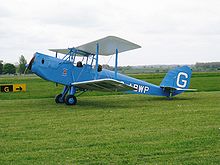 The Gipsy-powered Spartan Arrow
The Gipsy-powered Spartan Arrow
- Airspeed Ferry
- Avro Avian
- Blackburn Bluebird IV
- de Havilland DH.60G Gipsy Moth
- de Havilland DH.60T Gipsy Moth Trainer
- PZL.5
- RWD-4
- Saro Cutty Sark
- Saro Windhover
- Short Mussel
- Simmonds Spartan
- Southern Martlet
- Spartan Arrow
- Spartan Three Seater
- Gipsy III
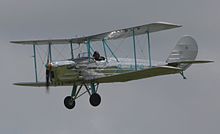 Preserved Blackburn B-2
Preserved Blackburn B-2
- Airspeed Ferry
- Arrow Active
- Avro Avian
- Bartel BM-4
- Blackburn Bluebird IV
- Blackburn B-2
- Blackburn-Saro Meteor
- Breda 33
- Cierva C.24
- Comper Swift
- Darmstadt D-22
- de Havilland Fox Moth
- de Havilland DH.60G Gipsy Moth
- de Havilland Hornet Moth
- de Havilland DH.60GIII Moth Major
- de Havilland Leopard Moth
- de Havilland Puss Moth
- de Havilland DH.82A Tiger Moth I
- de Havilland T.K.1
- Desoutter Mk.II
- Heinkel He 64C
- Klemm Kl 26
- Klemm Kl 27
- Klemm Kl 32
- Miles Hawk
- Miles Hawk Major
- PZL.19
- Saro Cutty Sark
- Saro-Percival Mailplane
- Spartan Cruiser
- Westland-Hill Pterodactyl
- Gipsy IV
- Gipsy R
Survivors
As of October 2010 approximately 17 Gipsy-powered de Havilland DH.60 Moths remain on the British register. Not all are currently airworthy.[7]
Engines on display
Preserved de Havilland Gipsy engines are on public display at the:
Specifications (Gipsy I)
Data from Bransom[1] and Lumsden.[5]
General characteristics
- Type: 4-cylinder air-cooled inline piston aircraft engine
- Bore: 4.5 in (114.3 mm)
- Stroke: 5 in (127 mm)
- Displacement: 318.1 cu in (5.21 L)
- Length: 40.5 in (1028.5 mm)
- Width: 20 in (508 mm)
- Height: 29.9 in (759.5 mm)
- Dry weight: 285 lb (129.3 kg)
Components
- Valvetrain: Overhead valve
- Fuel system: Zenith carburettor with altitude control
- Fuel type: Petrol (Aviation grade fuel not required)
- Cooling system: Air-cooled
Performance
- Power output: 85 hp at 1,900 rpm (sea level)
- Compression ratio: 5:1
- Power-to-weight ratio: 0.3 hp/lb
See also
- Related development
- Comparable engines
- Related lists
References
Notes
Bibliography
- Bransom, Alan. The Tiger Moth Story, Fourth Edition. Shrewsbury, UK: Airlife Publishing Ltd., 1991. ISBN 0-906393-19-1.
- Lumsden, Alec. British Piston Engines and their Aircraft. Marlborough, Wiltshire: Airlife Publishing, 2003. ISBN 1-85310-294-6.
External links
de Havilland aero engines Piston engines Ghost · Gipsy · Gipsy Junior · Gipsy Minor · Gipsy Major · Gipsy Six · Gipsy Queen · Gipsy Twelve · Gipsy King · Iris
Turbojet Ghost · Goblin · Gyron · Gyron Junior
Turboprop/turboshaft Rocket Designers Lists relating to aviation General Aircraft (manufacturers) · Aircraft engines (manufacturers) · Airlines (defunct) · Airports · Civil authorities · Museums · Registration prefixes · Rotorcraft (manufacturers) · TimelineMilitary Accidents/incidents Records Categories:- De Havilland aircraft engines
- Aircraft piston engines 1920-1929
Wikimedia Foundation. 2010.

